Year 9 Science exam 2022 checklist
Control & Regulation 3.1, 3.2, 3.3, 3.4, 3.6, 3.7 blood Glucose only.
Know the meaning of key terms such as receptor, stimulus, neurotransmitter, reflex, hormones, homeostasis, negative feedback, pathogen,
- Stimulus - something that stimulates/starts your brain and gets it thinking
- Receptors - a structure that detects stimuli or changes in the normal functioning of the body
- Neuron - a specialised nerve cell that transmits nerve impulses
- Neurotransmitter - a chemical messenger that moves from one axon to another via the synapse, it moves from the axon to the dendrite of another neuron
- Reflex - an involuntary action that is nearly instantaneous, a reaction movement that responds to a stimuli
- Hormone - a substance within an organism that is transported by tissue fluids to stimulate specific cells
- Homeostasis - the processing of regulating the internal conditions of the body
- Negative feedback - the body’s way of responding to a stimulus, by using effectors to remove the stimulus
- Sensory neurons - nerve cell that carries messages from receptors to the central nervous system
- Motor neurons/efferent neurons - carry messages from the central nervous system to muscle cells for them to carry out a response
- Interneurons/connector neurons - links sensory + motor neurons + other interneurons, most common neuron
- Synapse - the gap between 2 neurons that must be crossed by neurotransmitters
- Endocrine system - a collection of lands that make and secrete hormones directly into the blood
- Stimulus-response model - stimuli → receptors → sensory neurons send messages to the brain + spinal cord (CNS) → interneurons while the brain = making decision → when the decision is made, motor neurons → muscles/effectors cause the body to respond
Describe what a reflex action is and give an example.pg 54 **Give examples of stimuli detected by receptors What is the function of a motor neuron and a sensory neuron?
A reflex action is an involuntary action that responds to a stimulus.
- Plantar Reflex - when a blunt object is moved along the underside of the food, the toes curl downwards
- Patellar Reflex - small section below the kneecap (tendon connects to the muscle to the bone) is stimulated with a quick, firm, tap. The foot kicks out.
- Startle Reflex - when a newborn baby is startled, they will fling their arms out wide and grab anything they touch
- Sneeze Reflex - when mall particles land on receptors in the back of your diaphragm and it forces air out rapidly
- Grasp Reflex - object is placed on a baby’s palm their fingers over and grasp it
Motor neurons/efferent neurons - carry messages from the central nervous system to muscle cells for them to carry out a response
Interneurons/connector neurons - links sensory + motor neurons + other interneurons, most common neuron
List the difference between the CNS and PNS pg 50-51
The peripheral nervous system receives the info and the central nervous system process the info and decides what actions they need to do.
Peripheral nervous system - made up of nerves outside of the CNS, its role is to carry info from the receptors to the CNS
- Somatic - controls voluntary skeletal muscle movements e.g waving your hand
- Autonomic - controls involuntary actions that happen without conscious control e.g heart beating, respiration. Maintains homeostasis
The central nervous system - the control centre of our body, made up of the brain and spinal cord only, receives incoming messages from PNS, sends signals to muscles and glands as effectors
Identify parts of a neuron and state their functions. pg 56-57 Nerves label diagrams : dendrite, axon, nucleus, myelin sheath, Cell body of Motor neurons and Sensory neurons
- Axon - the part of a neuron that carries the electrical message away from the cell body to the synapse, neurotransmitters pass through the terminal to the dendrites of another neuron
- Myelin sheet - a fatty layer that covers the axon of a nerve cell
- Dendrites - the part of a neuron that receives the message and sends it to the cell body
- Terminal - responsible for sending the signal on to the other neurons
- Synapse - neurotransmitter binds to dendrites
Label a diagram of a neuron.pg 53
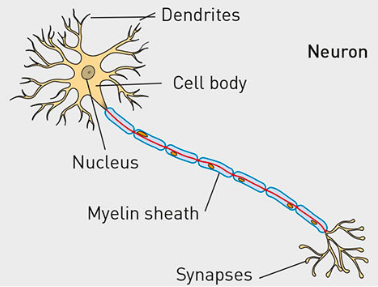
Recall the stimulus-response model and label diagrams of it including negative feedback.pg54 Stimulus/Receptor/ Control modulator/effector/Response
The stimulus is detected by receptors and a message is sent to the brain via sensory neurons. CNS = bain + spinal cord. Interneurons in the control centre pass messages to other interneurons as your brain decides how to respond. The brain makes decisions and motor neurons pass messages to muscles (effectors).
Contrast the nervous and endocrine systems' similarities and differences
They are both communication systems because chemical (endocrine) and electrical signals are passed within the body, allowing different parts of the body to work together in order to regulate. The nervous system is faster as the neurons are all connected, it helps create a faster response and detects stimuli from the outside world via sensory organs. The endocrine system however is more sensitive and it is involved in sensing and responding to the environment by using hormones to maintain homeostasis and regulate growth.
Read and interpret diagrams showing the regulation of substances in the body (Such as blood glucose regulation and water regulation) pg 63 Explain the concept of homeostasis. Eg body temperature and Glucose pg 62
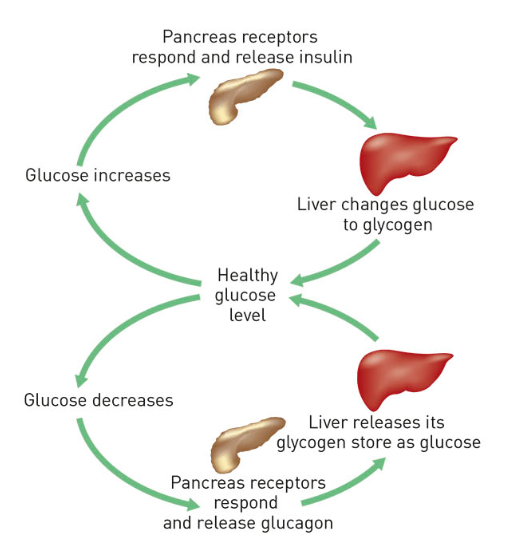
High glucose
high glucose level → pancreas receptors respond and release insulin → liver changes glucose to glycogen (the stored form of glucose)
Low glucose
glucose decreases → pancreas and receptors respond and release glucagon (a hormone that your pancreas makes to increase blood sugar level) → liver releases its glycogen stored as glucose
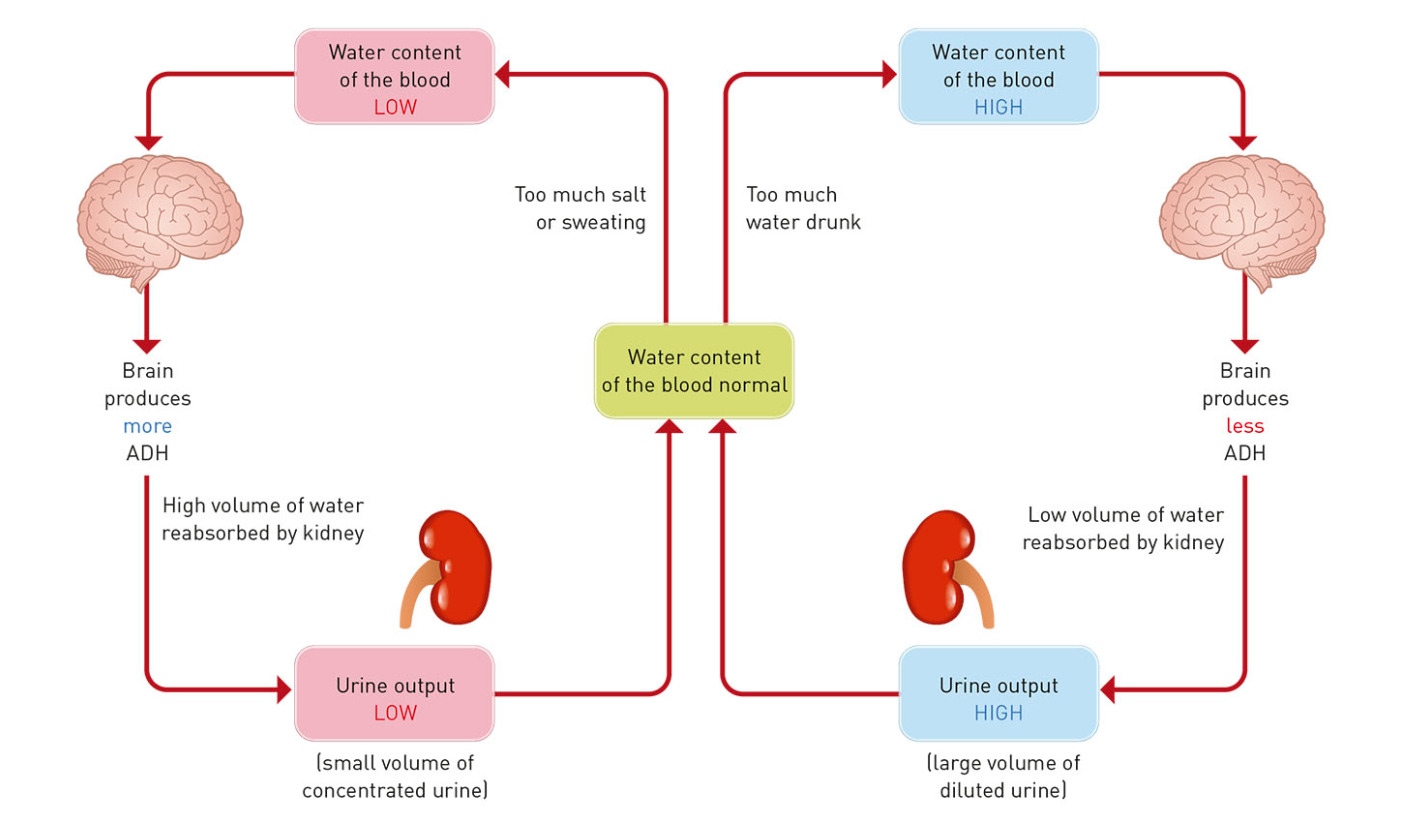
Low water
dehydration detected by receptors in the hypothalamus → pituitary glands release ADH (antidiuretic hormone, a chemical that helps kidneys manage water) → moves to kidney (target effector cells) → ADH binds to receptors on effector cells → reabsorbs water out of urine → gets back into the blood
High water
overhydration detected by receptors in the hypothalamus → pituitary gland to stop making ADH → effector cells detect lack of ADH → stops reabsorbing water
Homeostasis - the processing of regulating the internal conditions of the body
Increasing body temp
temp receptors in the skin + hypothalamus detect cold temp→ messages are sent to effectors → effectors make you shiver or blood vessels redirect warm blood flow to the heart, liver and brain. THIS IS NEGATIVE FEEDBACK
Decreasing body temp
temp receptors in the skin detect heat → effectors are sweat glands and blood vessels, they send warm blood to the skin and sweat glands produce sweat to be evaporated by the warm blood
Explain vaccine and vaccination What are they? How are they made? and how they protect the body?
Vaccination is the injection of specific small parts of a pathogen or dead pathogen or weakened but living pathogen, it is a way to acquire immunity against pathogens. They protect the body by helping to create memory cells from the b cells and t cells that were used to fight it so that in the future if the same pathogen comes back, the memory cells can help create b cells and t cells quickly.
Antibodies - a key and a lock mechanism that fit exactly onto a specific art of the pathogen and they each only fit on a section of the pathogen, they identify the pathogens by binding onto their specific markers and they stop them from reproducing and invading
Pathogens - a microbe that causes disease
- Describe the functions of the first, second and third lines of defence against disease. (chemical barriers, cilia, mucous, inflammation, phagocytes, antibodies) Pg 70 -71 Complete Chapter Review page 74 Qs 1 to 18
First line of defence
A barrier that prevents pathogens from entering the body, the barriers are skin and mucous membranes
Second line of defence
Respond in a general way to any pathogens that may have entered the body. iIt fights infections with fever or inflammation
- Fever, slows down or kills pathogens
- Inflammation, increases blood (blood = more white blood cells) white blood cells attack the pathogen → may release chemical messengers (swelling and more fluid.
- Phagocytes, non-specific immune responses → surround + absorb pathogens, the process is called phagocytosis
Third line of defence
Specific immune responses.
- B cells make antibodies that have a lock and key that fits onto specific parts of a pathogen (key) → each antibody fits only 1 section of a pathogen → causes the pathogen to be locked together → stops invasion.
- T cells recognise the same specific pathogen → kills
- B and T cells keep memory cells in case the pathogen comes back
Oxford Textbook: Electromagnetism (8.1, 8.2, 8.3)
Magnets - an object which is capable of producing a magnetic field and attracting unlike poles and repelling like poles.
Magnetic fields - generated when charged particles move through a wire
- North pole - the end of the magnet that will repel a south pole, magnetic field lines always point out of the north pole, a compass needle always points away from a magnet’s north pole. also painted red on a magnet
- South Pole - a compass needle always points toward a magnet's south pole; magnetic field lines point to the south pole but on the earth, the north pole is the south pole
Using electricity to create magnetic fields
Danish physicist Hans Christian Anderson discovered that wire carrying electric current caused a compass to move when switched on. Electricity can cause magnetism.
the singular current-carrying wire creates a circular magnetic gets weaker as distance increases
the magnetic field around a straight current-carrying wire is circular
the compass needle shows the direction of a magnetic field when placed in the field
the field around the outside of a magnet is always north pole → south pole
the direction of the magnetic field of the electrical wire is determined by the right-hand grip rule
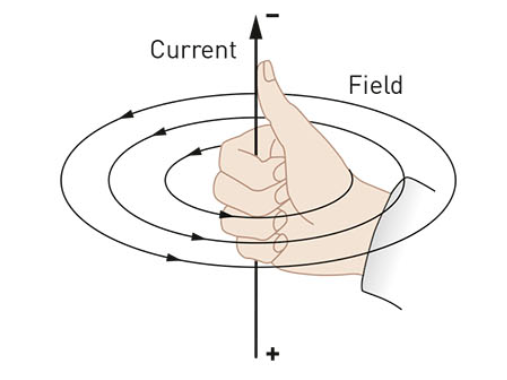
Determining the direction of the magnetic field
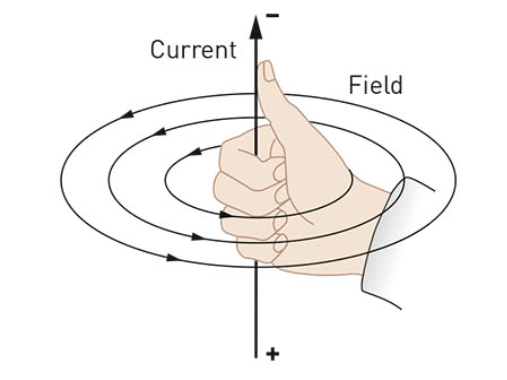
Thumb is pointed along the wire in the direction of the conventional (negative terminal current of the battery), The fingers curl in the circular direction of the magnetic field (anti-clockwise
Electromagnets
- long, single, current-carrying wire in coils to produce stronger, straighter magnetic fields
Solenoid what is it? and example of how it works
solenoid - a current-carrying wire that has an iron core made into an electromagnet
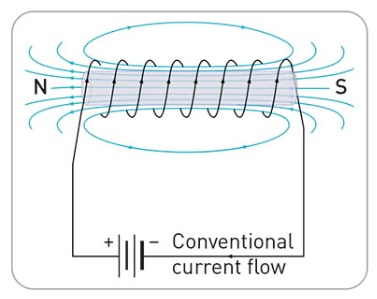
Current carrying wire
A current-carrying wire experiences a magnetic force when placed in a magnetic field produced by an external source such as a permanent magnet. A current-carrying wire also has a magnetic field of its own.
Danish Physicist: Hans Christian Oersted What did he do?
- Danish physicist Hans Christian Anderson discovered that wire carrying electric current caused a compass to move when switched on. Electricity can cause magnetism.
Magnetic elements Iron, nickel, Etc
Electric currents
a stream of charged particles moving through an electrical conductor such as electrons or ions moving through an electrical conductor or space
- Compass Currents
- a wire carrying electric current caused a compass to move when switched on. Electricity can cause magnetism.
- Fields
- a magnetic field surrounds a magnet
- when another metal enters the field, it experiences a force
- the force can attract or repel the metal
- force is stronger closer to the magnet
- The positive and negative terminal
- south is positive
- north is negative \n

- Permanent magnets and magnetic fields of electromagnets
- Permanent magnets are magnets that retain their magnetic properties for a long time
- Electric motors How they work and the different parts
- Coils - made of copper (v good conductor), wound around armature, when current flows through the coil → electromagnet
- Brushes - keeps contact with the commutator ven though it is spinning, the current flows in and out of the motor through the brushes
- Armature - supports coil, helps make coil stronger → motor more efficient
- Generator - a machine that uses electromagnetic effect to separate charges and produce electricity
- Commutator - each haf connects to the end of the coil, swaps contact every half turn
- Electromagnetic induction - production of a high voltage in a circuit by the magnetic field through the circuit or by the relative movement of the magnetic field and the circuit
Oxford Textbook: Chemical Reactions (6.1, 6.2, 6.3, 6.4, 6.5)
Know the meaning of key terms such as: reactants, products, pH scale, indicator, neutralisation, combustion,
Count the number of atoms of each element in a chemical formula or equation
Identify the reactants and products in a chemical reaction
Distinguish between exothermic and endothermic reactions and give examples of each
Reactants and product energy levels
Recall the properties of acids and bases
Read and interpret a pH scale
State the colours that universal indicator, litmus paper and red cabbage indicator turn in the presence of acids, bases and neutral substances.
Give some examples of common substances that are acids or bases.
\
Recognise and write word equations and symbol equations, for the following reactions…
*acid +base (neutralization reaction)Examples
HCL + NaOH NaCL + H20
Hydrochloric acid and sodium chloride
Antacids
*metal carbonate + base (neutralization reaction)*metal + acid
EG Hydrochloric acid and Magnesium chlorideMagnesium Chloride and water
*metal + oxygen*Rust
Iron and rust
Iron + Oxygen Iron oxide
Prevention
*fuel + oxygen (combustion reactions)
- Discuss acidic oceans acid rain and carbonic acid
*Explain the Law of conservation of matter
*Explain what is meant by Activation energy
*Acid rain
*Ocean acidification
Causes
Fixes
Calcium carbonate
*Carbonic acid
*Calcium carbonate
Shells and sea creatures
Complete Chapter Review
Science Investigations
• Variables
• ID and D
• Constant
• Graph plotting
Science skills
- Constructing graphs
- Interpret graph.
- Interpret diagrams.
EXTRA PRACTICE
STILE Lessons Control and Regulation Chapter STILE Lessons Chemical Reactions Chapter
1.1 a) Parts of the Nervous System 1.1 What are chemical reactions
1.1b) Stimulus Response
1a) and 1b) nervous system/ stimulus response quiz 2.2 Explosive chemical reactions
2.1 Hormones
2.1 quiz Hormones 3.1 Test chemical reactions
2.2 quiz Homeostasis
2.2 Homeostasis 3.1 Acids and Bases
3.1 Pathogens
3.1 quiz Pathogens 3.2 Measuring acidity
3,2 Infectious diseases
3.2 quiz infectious diseases 4.2 Acid base reactions
4.1 The First Line of Defence
4.1 quiz the first line of defence 5.1 Ocean acidification
4.2 The Second Line of Defence
4.2 quiz The Second Line of Defence 5.2 Test Acid and Bases
5.1 The Third Line of Defence
5.1 quiz The Third Line Of Defence 6.1 Combustion
5.2 Vaccinations
5.2 quiz Vaccinations 6.2 Test Combustion
7.1 Endothermic and Exothermic reactions
Glossary: The Nervous System 7.2 Test Endothermic and Exothermic reactions
Glossary: The Endocrine System Glossary: Chemical reactions
Glossary: The Immune System Glossary: Acids and Bases
Glossary; Reactions and Energy
Summative Quiz: Reactions and Energy
Electromagnetism STILE lessons
1.1 Magnets
2.1 Electromagnetism
2.4 Electromagnetism
Glossary Electromagnetism